In today’s fast-paced business landscape, maximizing productivity is not just an advantage—it’s a necessity. Enhancing your business efficiency can lead to increased profitability, improved employee morale, and a stronger competitive edge. But how do you achieve this? It’s not always about working harder, but smarter. Here are some productivity hacks to supercharge your business.
1. The Power of Planning and Prioritization
A well-structured plan is the cornerstone of productivity. Begin each day or week by listing tasks, then prioritize them based on importance and urgency. The Eisenhower Matrix, which categorizes tasks into urgent/important, important/not urgent, urgent/not important, and not urgent/not important quadrants, can be a useful tool for this.
2. Time Management Techniques
Effective time management is about more than just filling your calendar. Techniques like the Pomodoro Technique (working in 25-minute blocks followed by short breaks) can help maintain focus and prevent burnout. Timeboxing, allocating specific time slots for tasks, can also be beneficial.
3. Embrace Technology
Technology can be a productivity powerhouse. Project management tools like Asana or Trello, communication platforms like Slack, and time tracking software can streamline operations and enhance collaboration. Explore automation tools to handle repetitive tasks, freeing your team to focus on higher-value activities.
4. Cultivate a Productive Workspace
Your environment plays a significant role in your productivity. Ensure your workspace is well-lit, organized, and free from distractions. Personalize it with elements that inspire and motivate you. Consider incorporating plants, as they’ve been shown to enhance productivity and reduce stress. Additionally, understanding what is business days in shipping can help you better manage time-sensitive tasks and expectations.
5. Prioritize Well-being
A healthy and happy workforce is a productive one. Encourage regular breaks, physical activity, and a balanced diet. Offer resources for stress management, such as meditation or yoga classes. A well-rested and energized team is more focused and efficient.
6. Delegate Effectively
Micromanaging can stifle productivity. Learn to delegate tasks effectively. Trust your team members with responsibilities and empower them to make decisions. This not only frees up your time but also fosters a sense of ownership and engagement among employees.
7. Streamline Meetings
Meetings can be a notorious time-waster. Ensure every meeting has a clear agenda, invite only essential participants, and stick to the schedule. Consider alternatives like stand-up meetings or virtual huddles for quick updates.
8. Continuous Learning and Development
Encourage a culture of continuous learning and development within your organization. Provide training opportunities, workshops, or online courses to help employees upskill and stay abreast of industry trends. A knowledgeable workforce is a more adaptable and efficient one.
9. Data-Driven Decision Making
Don’t rely on gut feelings alone. Use data and analytics to inform your decisions. Track key performance indicators (KPIs) to identify bottlenecks, measure progress, and optimize processes.
10. Foster a Positive Work Culture
A positive work environment can significantly impact productivity. Encourage open communication, celebrate successes, and recognize individual contributions. Foster a sense of community and camaraderie among your team.
11. Embrace Flexibility
The traditional 9-to-5 workday isn’t for everyone. Consider offering flexible work arrangements, such as remote work or flexible hours. This can boost employee morale, reduce commute times, and accommodate individual preferences.
12. The Art of Saying No
It’s okay to say no to requests that don’t align with your priorities or goals. Overcommitting can lead to burnout and decreased productivity. Politely decline tasks that don’t serve your overall objectives.
Conclusion
Productivity is an ongoing journey, not a destination. It requires a commitment to continuous improvement, a willingness to experiment, and a focus on both individual and organizational well-being. By implementing these productivity hacks, you can create a more efficient, engaged, and successful business. Remember, it’s not about working harder—it’s about working smarter.




